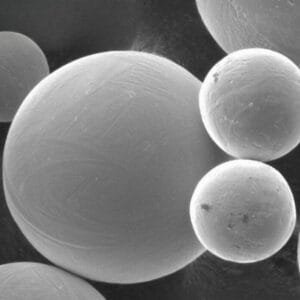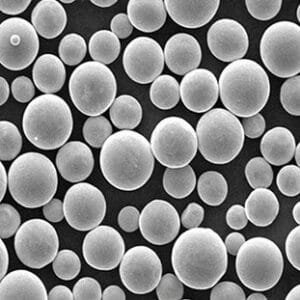Copper Powder Overview
Copper powder is a versatile material utilized across various industries, including diamond tools, electrocarbon products, powder metallurgy, friction materials, chemical catalysts, and electronic components. It is categorized into two main types: electrolytic copper powder and atomized copper powder.
Copper Alloy Powder
Copper alloy powder generally features a spherical or spheroidal shape, which contributes to its excellent fluidity and high bulk density. This type of powder is commonly used in powder metallurgy applications such as oil bearings, diamond tools, filters, and other bearing materials.
Electrolytic Copper Powder
Electrolytic copper powder is characterized by its light rose-red, dendritic form. Produced through electrolysis, this powder boasts high purity and distinctive tree-like branching particles. While initially dendritic, the particles tend to become slightly rounded after processing. This type of copper powder is prized for its excellent forming properties, electrical conductivity, and thermal conductivity. It is widely applied in manufacturing diamond tools, electric carbon products, friction materials, powder metallurgy products, and conductive inks, as well as in various electrical and electronic applications.
Products Series
| Grade | Cu≥ | O2% | AD (g/lcm3) | Powder Size Distribution (mesh) | ||||
|---|---|---|---|---|---|---|---|---|
| +100 | +150 | +200 | +325 | -325 | ||||
| Cu-A1 | 99.8 | 0.15 | 1.3-2.3 | – | – | 0-8 | 20-30 | 60-70 |
| Cu-A2 | 99.7 | 0.15 | 1.2-1.9 | – | – | Trace | 0-5 | 95-100 |
| Cu-A3 | 99.7 | 0.20 | 0.7-1.2 | – | – | 0-10 | 10-30 | Bal. |
Water Atomized Copper powder
The atomized copper powder is light rose red with irregular spherical particle. They mainly applicable to powder metallurgy, electrical alloys electroncarbon products, chemical catalst, heat treatment, sparing, plastic filling, decorative materials, welding powder, etc.
Products Series
| Grade | Cu≥ | O2% | AD (g/lcm3) | Hf (s/50g) | Powder Size Distribution (mesh) | ||||
|---|---|---|---|---|---|---|---|---|---|
| +100 | +150 | +200 | +325 | -325 | |||||
| Cu-B1 | 99.8 | 0.20 | 2.6-4.6 | 36 | – | – | – | 0-5 | 95-100 |
| Cu-B2 | 99.8 | 0.20 | 2.5-3.8 | 33 | – | 0-10 | 0-20 | Bal. | 50-70 |
| Cu-B3 | 99.8 | 0.20 | 2.0-3.3 | 30 | 0-10 | 10-30 | 30-70 | Bal. | 0-5 |
Tin Bronze powder
Tin Bronze powder used in copper-based oil bearing, friction materials, filters, bimetallic materials, sealing materials, diamond tools, conductive functions and other industries.material and so on.\
Products Series
| 6-6-3 powder | |||||||||||
|---|---|---|---|---|---|---|---|---|---|---|---|
| Grade | AD (g/lcm3) | Mobility | Compressibility | Granularity (mesh) | O2% | Chemical Composition (%) | |||||
| Cu | Sn | Zu | Pb | Fe | Ni | ||||||
| 6-6-3-A1 | 3.0-4.0 | 30-40 | ≥6.8 | -100 -200 | 0.30 | 84-86 | 5-7 | 5-7 | 2-4 | <0.03 | <0.01 |
| 6-6-3-A2 | 3.2-4.2 | 30-35 | ≥6.5 | -200 -300 | 0.30 | 84-96 | 5-7 | 5-7 | 2-4 | <0.03 | <0.01 |
Various models can be customized
| 6-6-0 powder | |||||||||||
|---|---|---|---|---|---|---|---|---|---|---|---|
| Grade | AD (g/lcm3) | Mobility | Compressibility | Granularity (mesh) | O2% | Chemical Composition (%) | |||||
| Cu | Sn | Zu | Pb | Fe | Ni | ||||||
| 6-6-0-A1 | 2.8-3.4 | 36-40 | >6.8 | -100 -200 | 0.30 | 87-89 | 5-7 | 5-7 | 0 | <0.03 | <0.01 |
| 6-6-0-A2 | 3.0-3.6 | 3.3-3.6 | >6.8 | -200 -300 | 0.30 | 87-89 | 5-7 | 5-7 | 0 | <0.03 | <0.01 |
Various models can be customized
Copper-Tin Alloy Powder
Copper powder is extensively utilized in several fields, including powder metallurgy, diamond tools, filter materials, bi-metal components, and conductive functional materials. Depending on the specific application, the copper powder can appear brown or apricot in color and is often irregularly spherical in shape.Products Series
| Grade | AD (g/lcm3) | D50 (um) | Compressibility | Granularity (mesh) | Chemical Composition (%) | ||
|---|---|---|---|---|---|---|---|
| Cu | Sn | O2% | |||||
| CuSn10 | 3.2-4.5 | ≤25 | ≥6.8 | -200,-300 | 90 | 10 | ≤0.20 |
| CuSn15 | 3.2-4.5 | ≤25 | ≥6.8 | -200,-300 | 85 | 15 | ≤0.20 |
| CuSn20 | 3.2-4.5 | ≤25 | ≥6.8 | -200,-300 | 80 | 20 | ≤0.20 |
| CuSn33 | 3.2-4.5 | ≤20 | >7.0 | -200,-300 | 67 | 33 | ≤0.20 |
| CuSn50 | 3.0-4.5 | ≤20 | >7.1 | -200,-300 | 50 | 50 | ≤0.20 |
| CuSn80 | 2.5-4.5 | ≤20 | ≥7.2 | -200,-300 | 20 | 50 | ≤0.20 |
Various models can be customized
Copper -Tin Diffusion Powder
Copper powder typically appears in shades of orange or khaki and features a dendritic micro-morphology. This powder is characterized by its low bulk density, narrow and uniform particle size distribution, and excellent compressibility and formability. These attributes significantly enhance the compaction strength of green billets.
Products Series
| Grade | AD (g/lcm3) | Granularity (mesh) | Chemical Composition (%) | |||
|---|---|---|---|---|---|---|
| Cu | Sn | Total Impurities | O2% | |||
| KS-CuSn10 | 1.90-2.50 | -200, -300 | 89-91 | 19-21 | ≤0.20 | ≤0.15 |
| KS-CuSn15 | 1.90-2.50 | -200, -300 | 84-86 | 14-16 | ≤0.20 | ≤0.20 |
| KS-CuSn20 | 1.90-2.50 | -200, -300 | 79-81 | 19-21 | ≤0.20 | ≤0.20 |





Reviews
There are no reviews yet.